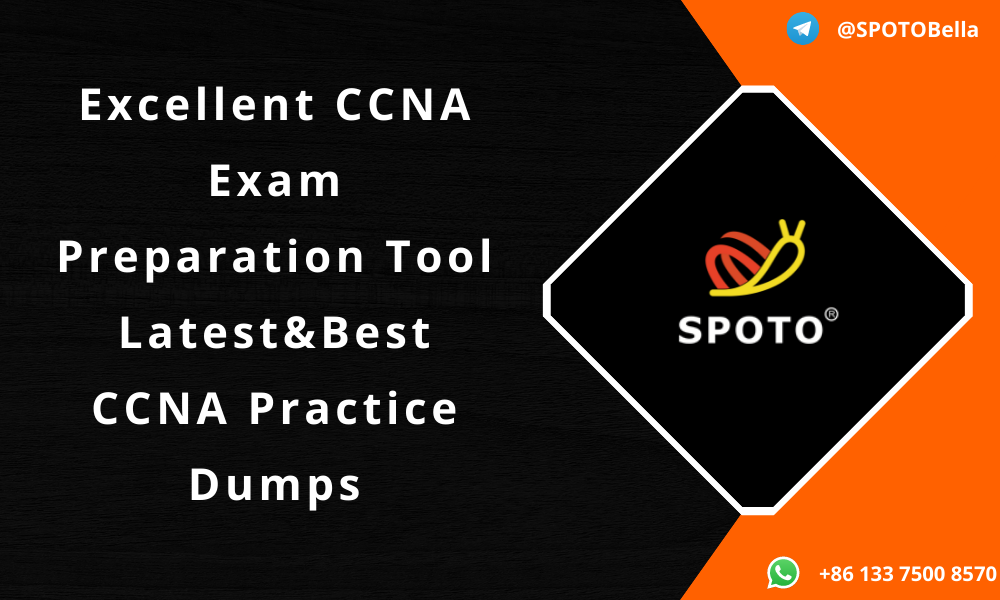If you want to improve your grades and boost your confidence before your CCNA exams, try SPOTO‘s CCNA® test dumps based on the latest test guideline,as well as to get a sense for the exam structure. Improve your speed and time management on the CCNA® exam by practicing the ten sample questions listed below.
Question 1
What are two potential network problems that can result from ARP operation? (Choose two.)
A. Manually configuring static ARP associations could facilitate ARP poisoning or MAC address spoofing.
B. On large networks with low bandwidth, multiple ARP broadcasts could cause data communication delays.
C. Network attackers could manipulate MAC address and IP address mappings in ARP messages with the intent of intercepting network traffic.
D. Large numbers of ARP request broadcasts could cause the host MAC address table to overflow and prevent the host from communicating on the network.
E. Multiple ARP replies result in the switch MAC address table containing entries that match the MAC addresses of hosts that are connected to the relevant switch port.
Correct answer: BC
Question 2
Which statement describes the treatment of ARP requests on the local link?
A. They must be forwarded by all routers on the local network.
B. They are received and processed by every device on the local network.
C. They are dropped by all switches on the local network.
D. They are received and processed only by the target device.
Correct answer: B
Question 3
Refer to the exhibit. The switches are in their default configuration. Host A needs to communicate with host D, but host A does not have the MAC address for its default gateway. Which network hosts will receive the ARP request sent by host A?
A. only host D
B. only router R1
C. only hosts A, B, and C
D. only hosts A, B, C, and D
E. only hosts B and C
F. only hosts B, C, and router R1
Correct answer: F
Question 4
Refer to the exhibit. A switch with a default configuration connects four hosts. The ARP table for host A is shown. What happens when host A wants to send an IP packet to host D?
A. Host A sends an ARP request to the MAC address of host D.
B. Host D sends an ARP request to host A.
C. Host A sends out the packet to the switch. The switch sends the packet only to the host D, which in turn responds.
D. Host A sends out a broadcast of FF:FF:FF:FF:FF:FF. Every other host connected to the switch receives the broadcast and host D responds with its MAC address.
Correct answer: D
Question 5
True or False?
When a device is sending data to another device on a remote network, the Ethernet frame is sent to the MAC address of the default gateway.
A. true
B. false
Correct answer: A
Question 6
The ARP table in a switch maps which two types of address together?
A. Layer 3 address to a Layer 2 address
B. Layer 3 address to a Layer 4 address
C. Layer 4 address to a Layer 2 address
D. Layer 2 address to a Layer 4 address
Correct answer: A
Question 7
A host is trying to send a packet to a device on a remote LAN segment, but there are currently no mappings in its ARP cache. How will the device obtain a destination MAC address?
A. It will send an ARP request for the MAC address of the destination device.
B. It will send an ARP request for the MAC address of the default gateway.
C. It will send the frame and use its own MAC address as the destination.
D. It will send the frame with a broadcast MAC address.
E. It will send a request to the DNS server for the destination MAC address.
Correct answer: B
Question 8
What is the purpose of the preamble in an Ethernet frame?
A. is used as a padding for data
B. is used for timing synchronization
C. is used to identify the source address
D. is used to identify the destination address
Correct answer: B
Question 9
What is the Layer 2 multicast MAC address that corresponds to the Layer 3 IPv4 multicast address 224.139.34.56?
A. 00-00-00-0B-22-38
B. 01-00-5E-0B-22-38
C. 01-5E-00-0B-22-38
D. FE-80-00-0B-22-38
E. FF-FF-FF-0B-22-38
Correct answer: B
Question 10
Which two statements are correct about MAC and IP addresses during data transmission if NAT is not involved? (Choose two.)
A. A packet that has crossed four routers has changed the destination IP address four times.
B. Destination MAC addresses will never change in a frame that goes across seven routers.
C. Destination and source MAC addresses have local significance and change every time a frame goes from one LAN to another.
D. Destination IP addresses in a packet header remain constant along the entire path to a target host.
E. Every time a frame is encapsulated with a new destination MAC address, a new destination IP address is needed.
Correct answer: CD
Conclusion
The preparation process for the forthcoming CCNA Exam in 2022 might not be easy, especially when there is a lot to learn in a short amount of time. SPOTO‘s CCNA® test dumps and training courses are the most effective approach to prepare for and track your progress toward the CCNA® certification.



Comments